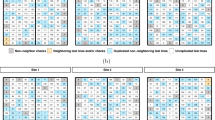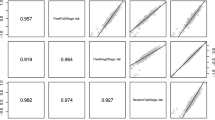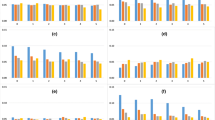Abstract
Key message
The paper shows that unreplicated designs in multi-environmental trials are most efficient. If replication per environment is needed then augmented p-rep designs outperform augmented and replicated designs in triticale and maize.
Abstract
In plant breeding, augmented designs with unreplicated entries are frequently used for early generation testing. With limited amount of seed, this design allows to use a maximum number of environments in multi-environmental trials (METs). Check plots enable the estimation of block effects, error variances and a connection of otherwise unconnected trials in METs. Cullis et al. (J Agri Biol Environ Stat 11:381–393, 2006) propose to replace check plots from a grid-plot design by plots of replicated entries leading to partially replicated (p-rep) designs. Williams et al. (Biom J 53:19–27, 2011) apply this idea to augmented designs (augmented p-rep designs). While p-rep designs are increasingly used in METs, a comparison of the efficiency of augmented p-rep designs and augmented designs in the range between replicated and unreplicated designs in METs is lacking. We simulated genetic effects and allocated them according to these four designs to plot yields of a triticale and a maize uniformity trial. The designs varied in the number of environments, but have a fixed number of entries and total plots. The error model and the assumption of fixed or random entry effects were varied in simulations. We extended our simulation for the triticale data by including correlated entry effects which are common in genomic selection. Results show an advantage of unreplicated and augmented p-rep designs and a preference for using random entry effects, especially in case of correlated effects reflecting relationships among entries. Spatial error models had minor advantages compared to purely randomization-based models.



Similar content being viewed by others
References
Akaike H (1974) New look at the statistical model identification. IEEE Trans Automat Contr AC 19:716–723
Alheit KV, Maurer HP, Reif JC, Matthew RT, Hahn V, Weissmann EA, Würschum T (2012) Genome-wide evaluation of genetic diversity and linkage disequilibrium in winter and spring triticale (X Triticosecale Wittmack). BMC Genom 13:235
Badea A, Eudes F, Salmon D, Tuvesson S, Vrolijk A, Larsson C-T, Caig V, Huttner E, Kilian A, Laroche A (2011) Development and assessment of DArT markers in triticale. Theor Appl Genet 122:1547–1560
Beeck CP, Cowling WA, Smith AB, Cullis BR (2010) Analysis of yield and oil from series of canola breeding trials. Part I. Fitting factor analytic mixed models with pedigree information. Genome 53:992–1001
Besag J, Kempton R (1986) Statistical analysis of field experiments using neighbouring plots. Biometrics 42:231–251
Burgueno J, Crossa J, Cotes JM, Vicente FS, Das B (2011) Prediction assessment of linear mixed models for multienvironment trials. Crop Sci 51:944–954
Butler DG, Tan MK, Cullis BR (2009) Improving the accuracy of selection for late maturity α-amylase in wheat using multi-phase designs. Crop Pasture Sci 60:1202–1208
Chandra S (1994) Efficiency of check plot designs in unreplicated field trials. Theor Appl Genet 88:618–620
Clarke GPY, Stefanova KT (2011) Optimal design for early-generation plant-breeding trials with unreplicated or partially replicated test lines. Aust NZ J Stat 53:461–480
Crawford AC, Stefanova K, Lambe W, McLean R, Wilson R, Barclay I, Francki MG (2011) Functional relationships of phytoene synthase 1 alleles on chromosome 7A controlling flour colour variation in selected Australian wheat genotypes. Theor Appl Genet 123:95–108
Crossa J, Burgueno J, Cornelius PL, McLaren G, Trethowan R, Krishnamachari A (2006) Modelling genotype × environment interaction using additive genetic covariances of relatives for predicting breeding values of wheat genotypes. Crop Sci 46:1722–1733
Cullis BR, Gleeson AC (1991) Spatial analysis of field experiments—an extension to two dimensions. Biometrics 47:1449–1460
Cullis BR, Smith AB, Coombes NE (2006) On the design of early generation variety trials with correlated data. J Agric Biol Environ Stat 11:381–393
Federer WT (1956) Augmented (or hoonuiaku) designs. Hawaii Plant Rec 55:191–208
Federer WT, Crossa J (2012) I.4 screening experimental designs for quantitative trait loci, association mapping, genotype-by environment interaction, and other investigations. Front Physiol 3:156
Fisher RA (1926) The arrangement of field experiments. J Min Agric G Br 33:503–513
Gabriel KR (1978) Least squares approximation of matrices by additive and multiplicative model. J R Statist S Ser B 40:186–196
Gilmour AR, Cullis BR, Verbyla AP (1997) Accounting for natural and extraneous variation in the analysis of field experiments. J Agric Biol Environ Stat 2:269–293
Gollob HF (1968) A statistical model that combines features of factor analysis and analysis of variance techniques. Psychometrika 33:73–115
Guo Z, Tucker DM, Lu J, Kishore V, Gay G (2012) Evaluation of genome-wide selection efficiency in maize nested association mapping populations. Theor Appl Genet 124:261–275
Hickey LT, Lawson W, Platz GJ, Dieters M, Arief VN, Germán S, Fletcher S, Park RF, Singh D, Pereyra S, Franckowiak J (2011) Mapping Rph20: a gene conferring adult plant resistance to Puccinia hordei in barley. Theor Appl Genet 123:55–68
Hill RR, Rosenberger JL (1985) Methods of combining data from germplams evaluation trials. Crop Sci 25:467–470
Jannink J-L, Lorenz AJ, Iwata H (2010) Genomic selection in plant breeding: from theory to practice. Brief Funct Genomics 9:166–177
Journel AG, Huijbregts CJ (1978) Mining geostatistics. Academic Press, London
Kehel Z, Habash DZ, Gezan SA, Welham SJ, Nachit MM (2010) Estimation of spatial trend and automatic model selection in augmented designs. Agron J 102:1542–1552
Kempton RA (1984) The design and analysis of unreplicated field trials. Vortr Pflanzenzuecht 7:219–242
Kleinknecht K, Möhring J, Singh KP, Zaidi PH, Atlin GN, Piepho H-P (2013) Comparison of the performance of BLUE and BLUP of genotype effects from zoned Indian maize data. Crop Sci 53:1384–1391
Laidig F, Drobek T, Meyer U (2008) Genotypic and environmental variability of yield for cultivars from 30 different crops in German official variety trials. Plant Breed 127:451–457
Mathews KL, Marosetti M, Chapman S, McIntyre L, Reynolds M, Shorter R, van Eeuwijk FA (2008) Multi-environment QTL mixed models for drought stress adaptation in wheat. Theor Appl Genet 117:1077–1091
Mead R, Gilmour SG, Mead A (2012) Statistical principles for the design of experiments: applications to real experiments. Cambridge series in statistical and probabilistic mathematics. Cambridge University Press, New York
Möhring J, Piepho H-P (2009) Comparison of weighting in two-stage analyses of series of experiments. Crop Sci 49:1977–1988
Müller BU, Schützenmeister A, Piepho H-P (2012) Arrangement of check plots in augmented block designs when spatial analysis is used. Plant Breed 129:581–589
Patterson HD, Hunter EA (1983) The efficiency of incomplete block designs in national list and recommended list cereal variety trials. J Agric Sci 101:427–433
Patterson HD, Thompson R (1971) Recovery of inter-block information when block sizes are unequal. Biometrika 58:545–554
Patterson HD, Williams ER (1976) A new class of resolvable incomplete block designs. Biometrika 63:83–92
Payne RW (2006) New and traditional methods for the analysis of unreplicated experiments. Crop Sci 46:2476–2481
Piepho H-P (2009) Ridge regression and extensions for genomewide selection in maize. Crop Sci 49:1165–1176
Piepho H-P, Möhring J (2006) Selection in cultivar trials––is it ignorable? Crop Sci 46:192–201
Piepho H-P, Möhring J, Melchinger AE, Büchse A (2008) BLUP for phenotypic selection in plant breeding and variety testing. Euphytica 161:209–228
Piepho H-P, Möhring J, Schulz-Streeck T, Ogutu JO (2012) A stage-wise approach for the analysis of multi-environment trials. Biom J 54:844–860
Piepho H-P, Möhring J, Williams ER (2013) Why randomize agricultural experiments? J Agron Crop Sci 199:374–383
Richter C, Kroschewski B (2012) Geostatistical models in agricultural field experiments: investigations based on uniformity trials. Agron J 104:91–105
Robbins KR, Backlund JE, Schnelle KD (2012) Spatial correlations of unreplicated trials using a two-dimensional spline. Crop Sci 52:1138–1144
Santos AH, Bearzoti E, Ferreira DF, da Silva Filho JL (2002) Simulation of mixed models in augmented design. Sci Agric 59:483–489
SAS Institute Inc. (2011) Base SAS® 9.3 Procedures Guide. Cary, NC: SAS Institute Inc
Schulz-Streeck T, Ogutu JO, Piepho H-P (2013) Comparisons of single-stage and two-stage approaches to genomic selection. Theor Appl Genet 126:69–82
Searle SR, Casella G, McCulloch CE (1992) Variance components. Wiley, New York, pp 268–269
Smith AB, Cullis BR, Gilmour AR (2001) Analyzing variety by environment trials using multiplicative mixed models and adjustments for spatial field trend. Biometrics 57:1138–1147
Smith AB, Cullis BR, Thompson R (2005) The analysis of crop cultivar breeding and evaluation trials: an overview of current mixed model approaches. J Agric Sci 143:449–462
Smith AB, Lim P, Cullis BR (2006) The design and analysis of multi-phase plant breeding experiments. J Agric Sci 144:393–409
Smith AB, Thompson R, Butler DG, Cullis BR (2011) The design and analysis of variety trials using mixtures of composite and individual plot samples. J R Stat S Ser C (Appl Stat) 60:437–455
Stanek EJ III, Well A, Ockene I (1999) Why not routinely use best linear unbiased predictors (BLUPs) as estimates of cholesterol, per cent fat from kcal and physical activity? Stat Med 18:2943–2959
Stefanova KT, Smith AB, Cullis BR (2009) Enhanced diagnostics for the spatial analysis of field trials. J Agric Biol Environ Stat 14:392–410
Stringer JK, Cullis BR (2002) Application of spatial analysis techniques to adjust for fertility trends and identify interplot competition in early stage sugarcane selection trials. Aust J Agric Res 53:911–918
Stroup WW, Mulitze DK (1991) Nearest neighbor adjusted best linear unbiased prediction. Am Stat 45:194–200
Talbot M (1984) Yield variability of crop varieties in the UK. J Agric Sci Cambridge 102:315–321
Viana JMS, Sobreira FM, De Resende MDV, Faria VR (2010) Multi-trait BLUP in half-sib selection of annual crops. Plant Breed 129:599–604
Welham SJ, Gogel BJ, Smith AB, Thompson R, Cullis BR (2010) A comparison of analysis methods for late-stage variety evaluation trials. Aust NZ J Stat 52:125–149
Wiebe GA (1935) Variation and correlation in grain yield among 1500 wheat nursery plots. J Agric Res 50:331–357
Williams ER (1986) Neighbour analysis of uniformity data. Aust J Stat 28:182–191
Williams ER, Luckett DJ (1988) The use of uniformity data in the design and analysis of cotton and barley variety trials. Aust J Agric Res 39:339–350
Williams ER, John JA, Whitaker D (2006) Construction of resolvable spatial row–column designs. Biometrics 62:103–108
Williams ER, Piepho H-P, Whitaker D (2011) Augmented p-rep designs. Biom J 53:19–27
Wu T, Dutilleul P (1999) Validity and efficiency of neighbor analyses in comparison with classical complete and incomplete block analyses of field experiments. Agron J 91:721–731
Wu T, Mather DE, Dutilleul P (1998) Application of geostatistical and neighbor analyses to data from plant breeding trial. Crop Sci 38:1533–1545
Zimmerman DL, Harville DA (1991) A random field approach to the analysis of field-plot experiments and other spatial experiments. Biometrics 47:223–239
Acknowledgments
Jens Möhring was supported by DFG Grant PI 377/13-1. We thank two anonymous reviewers for their helpful comments. The DArT marker data were created within research project 0315414A, funded by the Federal Ministry of Education and Research (BMBF), Germany.
Conflict of interest
The authors declare that they have no conflict of interest.
Author information
Authors and Affiliations
Corresponding author
Additional information
Communicated by I. Mackay.
Electronic supplementary material
Below is the link to the electronic supplementary material.
Rights and permissions
About this article
Cite this article
Moehring, J., Williams, E.R. & Piepho, HP. Efficiency of augmented p-rep designs in multi-environmental trials. Theor Appl Genet 127, 1049–1060 (2014). https://doi.org/10.1007/s00122-014-2278-y
Received:
Accepted:
Published:
Issue Date:
DOI: https://doi.org/10.1007/s00122-014-2278-y




